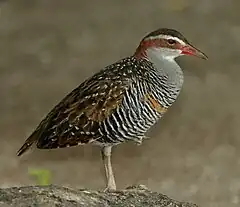| Hypotaenidia | |||
| Reichenbach, 1853[1] | |||
 Przedstawiciel rodzaju – wodnik białobrewy (H. philippensis) | |||
| Systematyka | |||
| Domena | |||
|---|---|---|---|
| Królestwo | |||
| Typ | |||
| Podtyp | |||
| Gromada | |||
| Podgromada | |||
| Infragromada | |||
| Rząd | |||
| Nadrodzina | |||
| Rodzina | |||
| Podrodzina | |||
| Rodzaj |
Hypotaenidia | ||
| Typ nomenklatoryczny | |||
|
Rallus philippensis Linnaeus, 1766 | |||
| Synonimy | |||
| |||
| Gatunki | |||
| |||
Hypotaenidia – rodzaj ptaków z rodziny chruścieli (Rallidae).
Zasięg występowania
Rodzaj obejmuje gatunki występujące w Australii, na wyspach Oceanii i Azji Południowo-Wschodniej oraz na japońskiej wyspie Okinawa[8][9].
Morfologia
Długość ciała 25–42 cm, rozpiętość skrzydeł 40–60 cm; masa ciała samców 126–780 g, samic 115–615 g[8].
Systematyka
Etymologia
- Hypotaenidia: gr. ὑπο hupo „pod, poniżej”; ταινιδιον tainidion „mała opaska”, od zdrobnienia ταινια tainia „opaska”[10].
- Stictolimnas: gr. στικτος stiktos „kropkowany”, od στιζω stizō „tatuować”; nowołac. limnas „wodnik”, od gr. λιμνας limnas „z bagna”, od λιμνη limnē „bagno, mokradło”[11]. Gatunek typowy: Stictolimnas sharpei Büttikofer, 1893 (= Rallus philippensis Linnaeus, 1766).
- Nesolimnas: gr. νησος nēsos „wyspa” (tj. Chatham); nowołac. limnas „wodnik”, od gr. λιμνας limnas „z bagna”, od λιμνη limnē „bagno, mokradło”[12]. Gatunek typowy: Rallus dieffenbachii G.R. Gray, 1843.
- Sylvestrornis: łac. silvestris „żyjący w lesie”, od silva „las, teren lesisty”; gr. ορνις ornis, ορνιθος ornithos „ptak”[13]. Gatunek typowy: Ocydromus sylvestris P.L. Sclater, 1870.
- Tahitornis: Tahiti, Polinezja Francuska (dawniej Taïti lub Otaheite); gr. ορνις ornis, ορνιθος ornithos „ptak”[14]. Gatunek typowy: Rallus pacificus J.F. Gmelin, 1789.
- Habropteryx: gr. ἁβρος habros „słaby, delikatny”; πτερυξ pterux, πτερυγος pterugos „skrzydło”[15]. Gatunek typowy: Rallus insignis P.L. Sclater, 1880 (= Rallus philippensis Linnaeus, 1766).
- Nesoclopeus: gr. νησος nēsos „wyspa” (tj. Viti Levu, Fidżi); κλοπευς klopeus „złodziej” (tj. ukradkowy), od κλεπτω kleptō kraść[16]. Gatunek typowy: Rallina poeciloptera Hartlaub, 1866.
Podział systematyczny
Do rodzaju należą następujące gatunki[17]:
- Hypotaenidia okinawae (Yamashina & Mano, 1981) – wodnik okinawski
- Hypotaenidia torquata (Linnaeus, 1766) – wodnik wąsaty
- Hypotaenidia insignis (P.L. Sclater, 1880) – wodnik różowonogi
- Hypotaenidia poeciloptera (Hartlaub, 1866) – wodnik brązowogrzbiety – takson wymarły około 1970 roku[18]
- Hypotaenidia woodfordi (Ogilvie-Grant, 1889) – wodnik smolisty
- Hypotaenidia rovianae (Diamond, 1991) – wodnik melanezyjski
- Hypotaenidia owstoni Rothschild, 1895 – wodnik guamski – takson wymarły na wolności[19]
- Hypotaenidia wakensis Rothschild, 1903 – wodnik mikronezyjski – takson wymarły przed 1946 rokiem[20]
- Hypotaenidia dieffenbachii (G.R. Gray, 1843) – wodnik chathamski – takson wymarły około 1872 roku[21]
- Hypotaenidia sylvestris (P.L. Sclater, 1870) – wodnik brunatny
- Hypotaenidia philippensis (Linnaeus, 1766) – wodnik białobrewy
- Hypotaenidia pacifica (J.F. Gmelin, 1789) – wodnik pacyficzny – takson wymarły najprawdopodobniej w latach 30. XX wieku[22]
Przypisy
- ↑ H.G.L. Reichenbach: Avium systema naturale. Das natürliche system der vögel mit hundert tafeln grösstentheils original-abbildungen der bis jetzt entdecken fast zwölfhundert typischen formen. Vorlaüfer einer iconographie der arten der vögel aller welttheile. Dresden und Leipzig: Expedition der vollständigsten naturgeschichte, 1853, s. xxiii. (niem.).
- ↑ J. Büttikofer. Description of a new genus of Crakes. „Notes from the Leyden Museum”. 15, s. 274, 1893. (ang.).
- ↑ Andrews. On the extinct birds of the Chatham Islands. Part II.—The osteology of palaeolimnas chathamensis and Nesolimnas (Gen. Nov.) dieffenbachii. „Novitates zoologicae”. 3, s. 266, 1896. (ang.).
- ↑ G.M. Mathews: The birds of Norfolk & Lord Howe Islands and the Australasian South Polar quadrant: with additions to "birds of Australia". London: H.F. & G. Witherby, 1928, s. 4. (ang.).
- ↑ G.M. Mathews: Systema Avium Australasianarum: a systematic list of the birds of the Australasian region. Cz. 2. (London): British Ornithologists’ Union, 1930, s. 904. (ang.).
- ↑ E. Stresemann. Habropteryx novum genus Rallidarum. „Ornithologische Monatsberichte”. 40, s. 122, 1932. (niem.).
- ↑ J.L. Peters. A New Genus for Rallus Poeciloptera. „The Auk”. 49 (3), s. 348, 1932. (ang.).
- 1 2 P.B. Taylor: Family Rallidae (Rails, Gallinules and Coots). W: J. del Hoyo, A. Elliott & J. Sargatal: Handbook of the Birds of the World. Cz. 3: Hoatzin to Auks. Barcelona: Lynx Edicions, 1996, s. 161–164. ISBN 84-87334-20-2. (ang.).
- ↑ F. Gill, D. Donsker & P. Rasmussen (red.): IOC World Bird List (v11.2). [dostęp 2021-12-29]. (ang.).
- ↑ The Key to Scientific Names ↓, Hypotaenidia [dostęp 2021-12-29].
- ↑ The Key to Scientific Names ↓, Stictolimnas [dostęp 2021-12-29].
- ↑ The Key to Scientific Names ↓, Nesolimnas [dostęp 2021-12-29].
- ↑ The Key to Scientific Names ↓, Sylvestrornis [dostęp 2021-12-29].
- ↑ The Key to Scientific Names ↓, Tahitornis [dostęp 2021-12-29].
- ↑ The Key to Scientific Names ↓, Habropteryx [dostęp 2021-12-29].
- ↑ The Key to Scientific Names ↓, Nesoclopeus [dostęp 2021-12-29].
- ↑ Systematyka i nazwy polskie za: P. Mielczarek, M. Kuziemko: Rodzina: Rallidae Rafinesque, 1815 - chruściele - Rails and Coots (wersja: 2020-03-14). [w:] Kompletna lista ptaków świata [on-line]. Instytut Nauk o Środowisku Uniwersytetu Jagiellońskiego. [dostęp 2020-03-19].
- ↑ BirdLife International, Hypotaenidia poeciloptera, [w:] The IUCN Red List of Threatened Species 2016, wersja 2019-3 [dostęp 2020-03-19] (ang.).
- ↑ BirdLife International, Hypotaenidia owstoni, [w:] The IUCN Red List of Threatened Species 2016, wersja 2019-3 [dostęp 2020-03-19] (ang.).
- ↑ BirdLife International, Hypotaenidia wakensis, [w:] The IUCN Red List of Threatened Species 2016, wersja 2019-3 [dostęp 2020-03-19] (ang.).
- ↑ BirdLife International, Hypotaenidia dieffenbachii, [w:] The IUCN Red List of Threatened Species 2016, wersja 2019-3 [dostęp 2020-03-19] (ang.).
- ↑ BirdLife International, Hypotaenidia pacifica, [w:] The IUCN Red List of Threatened Species 2016, wersja 2019-3 [dostęp 2020-03-19] (ang.).
Bibliografia
- The Key to Scientific Names, J.A. Jobling (red.), [w:] Birds of the World, S.M. Billerman et al. (red.), Cornell Lab of Ornithology, Ithaca (ang.).
This article is issued from Wikipedia. The text is licensed under Creative Commons - Attribution - Sharealike. Additional terms may apply for the media files.